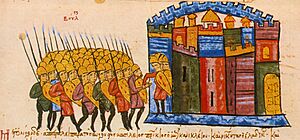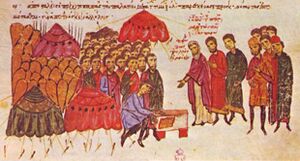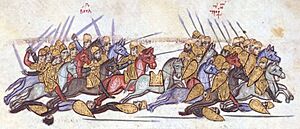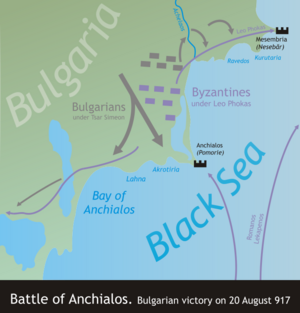Battle of Achelous (917) facts for kids
Quick facts for kids Battle of Achelous |
|||||||
|---|---|---|---|---|---|---|---|
| Part of the Byzantine–Bulgarian wars: War of 913–927 |
|||||||
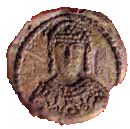 Seal of Simeon I |
|||||||
|
|||||||
| Belligerents | |||||||
| Bulgarian Empire | Byzantine Empire | ||||||
| Commanders and leaders | |||||||
| Simeon I of Bulgaria | Leo Phokas | ||||||
| Strength | |||||||
| 15,000 | 30,000 | ||||||
| Casualties and losses | |||||||
| Unknown | Unknown (heavy) | ||||||
The Battle of Achelous (also called Acheloos or Anchialus) was a huge fight between the Bulgarians and the Byzantine Empire. It happened on August 20, 917, near the Achelous River in modern-day Bulgaria. This battle was a massive victory for the Bulgarians. It helped their leader, Simeon I, become the most powerful ruler in the Balkan Peninsula.
This battle was one of the largest and bloodiest in the European Middle Ages. It was a terrible defeat for the Byzantines, but a huge triumph for Bulgaria. A key result was that the Byzantine Empire officially recognized the Bulgarian ruler as an Emperor. This showed that Bulgaria was an equal and important power.
Contents
Why the Battle Happened
After an earlier war (894–896), the Byzantines had to pay a yearly payment, called tribute, to the Bulgarian Tsar Simeon I. In 912, the Byzantine Emperor Leo VI died. His brother, Alexander, then refused to pay this tribute.
Simeon saw this as a chance to start a new war. He wanted to conquer Constantinople, the Byzantine capital. Emperor Alexander died that same year. The new Byzantine government, led by Patriarch Nicholas Mystikos, tried hard to avoid war. They even suggested that the young Emperor Constantine VII marry one of Simeon's daughters.
Simeon and the Patriarch met outside Constantinople. Simeon was even crowned there. After this, Simeon started using the title "Tsar of the Bulgarians." He also used the Greek title basileus, which meant Emperor.
However, in 914, there was a change in the Byzantine court. The new ruler, Empress Zoe (Constantine's mother), stopped the marriage plan. In response, the Bulgarians attacked eastern Thrace. In September 914, the city of Adrianople opened its gates to Simeon. Its people accepted him as their ruler. The Byzantine army was busy fighting in the east. The next year, Bulgarian armies attacked areas like Dyrrhachium and Thessalonica.
Getting Ready for Battle
Both sides prepared carefully for a major fight. Empress Zoe wanted to make peace quickly with the Arabs in the east. This would allow her to bring all her eastern armies to fight Simeon. The Byzantines also tried to find allies. They sent messengers to the Magyars, Pechenegs, and Serbs.
But Simeon knew about Byzantine diplomacy. He quickly worked to stop any alliances against him. So, the Byzantines had to fight alone.
The Byzantine Army
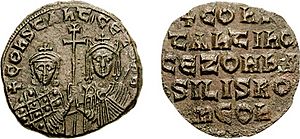
By 917, the Byzantine Empire had secured its eastern borders. Generals John Bogas and Leo Phocas brought more soldiers from Asia Minor. These joined the main imperial armies and European troops. They gathered a huge force of about 60,000 men. This was a very large army for that time. Their goal was to completely defeat the Bulgarians.
The Byzantine commanders felt sure they would win. Soldiers swore to fight to the death. Their spirits were high because they were paid in advance. A fleet, led by Romanus Lecapenus, sailed north to the mouth of the Danube River. The Byzantines had tried to pay some Pecheneg tribes to attack Bulgaria. But Romanus would not transport them across the Danube. So, the Pechenegs attacked Bulgarian land on their own.
The Bulgarian Army
We don't know the exact size of the Bulgarian army under Simeon I. Even though they stopped the Byzantine alliances, the Bulgarians worried about attacks from the north. They feared their old enemies, the Pechenegs and Hungarians. So, two smaller armies were sent to protect the northern borders of the large Bulgarian Empire. This empire stretched from Bosnia in the west to the Dnieper River in the east.
Some old writings suggest the Bulgarian army had help from Hungarian and Pecheneg troops at Achelous. However, other writings from that time, including a letter from Patriarch Nicholas Mystikos, say this is not true. In fact, the Hungarians were often allies of the Byzantine Empire around that time. Also, Bulgarian forces were sent to the western borders to prevent problems with the Serb areas.
The Battle Begins
The Byzantine army marched north and set up camp near the strong fortress of Anchialus. Leo Phocas planned to invade Moesia. He wanted to meet the Pechenegs and Lecapenus's troops in Dobrudzha. Simeon quickly gathered his army on the hills around the fortress.
On the morning of August 20, the battle started by the Achelous River. This was near the modern village of Acheloi, about 8 kilometers north of Anchialus (today's Pomorie) on Bulgaria's Black Sea coast. The Byzantine generals planned to attack the Bulgarian right side. They hoped to cut off Simeon's troops from the mountain passes.
Simeon, the Bulgarian ruler, put his strongest forces on the two sides of his army. He left the middle part weaker. His plan was to surround the enemy when the Byzantine attack pushed back his center. Simeon himself led a large group of cavalry (soldiers on horseback). These were hidden behind the hills, ready to deliver the final blow.
The Byzantine attack was very strong. Soon, the Bulgarians began to slowly fall back. The Byzantine cavalry charged into the Bulgarian foot soldiers, killing many. The Bulgarian situation looked bad. They couldn't hold the hills south of the river and started to retreat quickly to the north.
The Byzantines were excited and chased after them. Their battle lines started to break apart. A rumor even spread that the Byzantine commander, Leo Phocas, had been killed. At this moment, Simeon saw the confusion in the Byzantine army. He ordered his army to stop retreating. Then, leading his heavy cavalry, he attacked the Byzantine left side from behind the hills. The cavalry charged with great force into the confused enemy. The Byzantines immediately broke, panicked, and ran away.
...And even now there could be seen piles of bones at Anchialus, where the fleeing army of the Romans was disgracefully slain.
Some Byzantines tried to fight back against the cavalry charge. But they were also attacked by the Bulgarian foot soldiers. Tsar Simeon himself fought in the battle. His white horse was killed during the intense fighting. The Byzantines were completely defeated. Leo Phocas escaped by fleeing to Mesembria (modern Nesebar) in Bulgaria. But many other commanders and countless soldiers were killed. By the end of the day, the Bulgarians captured Mesembria. Leo Phocas barely escaped by getting on a ship.
The Byzantine historian Leo the Deacon wrote that 75 years after this disaster, the battlefield at Anchialus was still covered with tens of thousands of Byzantine skeletons. This battle was one of the bloodiest in medieval history. Some historians call it "the battle of the century."
What Happened Next
The remaining Byzantine army fled all the way back to Constantinople. The Bulgarians followed them. A few days later, Leo Phocas was defeated again at Katasyrtai. The last Byzantine troops were routed after a night fight. The path to Constantinople was now open.
The Byzantines offered a new peace deal. Simeon entered the imperial city and was crowned a second time. He was now "Tsar" (the Slavic word for Caesar or Emperor) "of all Bulgarians and Romans." Simeon also wanted his daughter to marry Constantine VII, the son of Empress Zoe Karvounopsina. But Zoe refused. Instead, she allied with Serbia and Hungary against him.
However, in August 918, a general named Romanus Lecapenus took power. He removed Zoe and sent her to a monastery. This allowed him to become Emperor. The alliance with the Serbs gave the Byzantines valuable time to recover. Simeon had suffered heavy losses too. He decided to secure his borders and sent an army to deal with the Serbs. His generals captured the Serb prince. But this gave the Byzantines more time to rebuild their forces. Simeon did not have enough soldiers to fight on both sides at once.
Why This Battle Was Important
The Battle of Achelous was one of the most important battles in the long Byzantine–Bulgarian Wars. It led to the Byzantine Empire officially recognizing the Bulgarian ruler's imperial title. This firmly established Bulgaria as a key power in Europe.
However, the marriage Simeon wanted between his daughter and the Byzantine imperial family did not happen. After Simeon's death in 927, his successor, Peter I, was able to achieve a marriage. He married Maria Lecapene, the granddaughter of Emperor Romanus I. This agreement also brought a yearly payment to Bulgaria. It renewed the recognition of the Bulgarian Emperor's title and the independence of the Bulgarian church. This agreement led to an amazing 40 years of peace between the two empires. It was a time of stability and success for Bulgaria.
|


